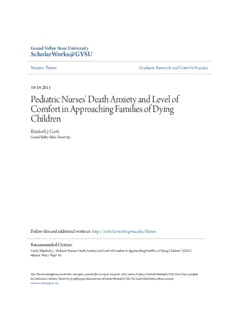
Pediatric Nurses' Death Anxiety and Level of Comfort in Approaching Families of Dying Children PDF
Preview Pediatric Nurses' Death Anxiety and Level of Comfort in Approaching Families of Dying Children
Grand Valley State University ScholarWorks@GVSU Masters Theses Graduate Research and Creative Practice 10-18-2011 Pediatric Nurses' Death Anxiety and Level of Comfort in Approaching Families of Dying Children Elizabeth J. Cook Grand Valley State University Follow this and additional works at:http://scholarworks.gvsu.edu/theses Recommended Citation Cook, Elizabeth J., "Pediatric Nurses' Death Anxiety and Level of Comfort in Approaching Families of Dying Children" (2011). Masters Theses.Paper 10. This Thesis is brought to you for free and open access by the Graduate Research and Creative Practice at ScholarWorks@GVSU. It has been accepted for inclusion in Masters Theses by an authorized administrator of ScholarWorks@GVSU. For more information, please contact [email protected]. PEDIATRIC NURSES’ DEATH ANXIETY AND LEVEL OF COMFORT IN APPROACHING FAMILIES OF DYING CHILDREN By Elizabeth June Cook A THESIS Submitted to Grand Valley State University In partial fulfillment of the requirements for the Degree of MASTER OF SCIENCE IN NURSING 2011 Kirkhof College of Nursing Thesis Committee Members: Linda Nicholson Grinstead, PhD, RN Ruth Ann Brintnall, PhD, RN Nancy Kingma, MA, BSN, RN, LLP, LPC ABSTRACT PEDIATRIC NURSES’ DEATH ANXIETY AND LEVEL OF COMFORT IN APPROACHING FAMILIES OF DYING CHILDREN By Elizabeth June Cook The purpose of this study is to examine how demographics; bereavement education; personal death anxiety; and frequency of interaction with death and dying; impact the level of comfort pediatric nurses have in approaching families of dying children. Watson’s Theory of Human Caring (n.d.) and the Quality Caring Model (Duffy & Hoskins, 2003) provide the theoretical framework for nursing actions and outcomes. The convenience sample of 165 pediatric nurses comes from a metropolitan children’s hospital population of 425 pediatric nurses. Nurses are recruited by a mass e-mail to their work e-mails with a link to the online survey. Nurses’ comfort level in approaching families of dying children is positively related to pediatric nursing experience; bereavement and emotionally charged communication education; choosing to interact with families of dying children; and frequency of interactions. Comfort level was not associated with total DAS score. Dedication This thesis is dedicated to Niki, a baby who lived to 14 weeks gestation, whose family tried for 10 years to have her, the families impacted by the death of a loved one, and all the nurses who care for them. i Acknowledgements Thanks to God, my father in heaven for placing within me the desire and capacity to care for others. To Jason my husband for allowing me to work towards my masters degree and providing loving support as well as the “voice of reason” to my heart. To Nicki, my thesis chair, for being understanding and encouraging when the work felt overwhelming. To Nancy Kingma for emphasizing the importance of caring for families after they have lost a loved one. And to my mom for teaching me how to look into the soul of others and love them no matter where they are at in life. ii Table of Contents List of Tables .......................................................................................................................v List of Figures .................................................................................................................... vi List of Appendices ............................................................................................................ vii CHAPTER 1 INTRODUCTION ...................................................................................................1 Problem Statement ...........................................................................................3 Purpose .............................................................................................................4 2 CONCEPTUAL FRAMEWORK AND LITERATURE REVIEW ........................5 Conceptual Framework ....................................................................................5 Summary ..........................................................................................................8 Literature Review .............................................................................................9 Research Questions ........................................................................................48 Definition of Terms ........................................................................................49 3 METHODS ....................................................................................................................51 Design .............................................................................................................51 Sample and Setting .........................................................................................52 Instruments .....................................................................................................52 Independent/Dependent Variables .................................................................54 Procedure ........................................................................................................54 4 RESULTS AND DATA ANALYSIS ...........................................................................56 Quantitative Findings .....................................................................................57 Qualitative Findings .......................................................................................67 5 DISCUSSION AND IMPLICATIONS .........................................................................70 Demographics .................................................................................................70 Comfort Level in Approaching Families of Dying Children .........................73 Choosing to Interact with Families of Dying Children ..................................74 Death Anxiety .................................................................................................75 Qualitative Results .........................................................................................77 iii Alternative Explanations ................................................................................78 Impact of Study ..............................................................................................78 Strengths .........................................................................................................79 Weaknesses and Limitations ..........................................................................79 Professional Implications ...............................................................................80 Further Research .............................................................................................82 Results and Conceptual Framework ...............................................................83 Summary ........................................................................................................84 APPENDICES ...................................................................................................................85 REFERENCES ................................................................................................................100 iv List of Tables Table 1. Demographic: Age ...............................................................................................58 Table 2. Experience: Nursing Specialty.............................................................................60 Table 3. Experience: Pediatric Nursing Experience ..........................................................61 Table 4. Education: Bereavement and Emotionally Charged Communication .................62 Table 5. Comfort Level Correlation Matrix .......................................................................63 Table 6. Nursing Specialty DAS Score Means ..................................................................66 v List of Figures Figure 1. The Ten Caritas ....................................................................................................6 Figure 2. The Bereavement Caring Model ..........................................................................7 vi
Description: